Baekryeong Island (centred at approximately 37.96° N 124.65° E) is the northernmost, largest and most populated of three ROK islands lying off far western Hwanghaenam Province. At closest, the island is only 16km from the DRPK mainland to the north and east, and 180km east-northeast of the Shandong Peninsula (China).
Although well-situated for research on bird migration (lying across the main northern migration corridor from China to the Korean Peninsula: see Moores 2012), Baekryeong has an estimated area of between 4,580ha (online sources) and 5,800ha (estimated through DaftLogic.com, and including the reservoir and beaches) – making coverage of the whole island by a single observer in a single day more or less impossible (unless driving). Moreover, although well-populated (with c. 4, 500 civilian residents alone) and with good roads, large parts of the island are rather sensitive (no big lenses allowed!) and many areas are presently inaccessible to civilians.
Despite the obvious challenges, initial survey work in early March (http://www.birdskoreablog.org/?p=7914) confirmed the presence of some excellent patches of habitat, a good diversity of species, genuinely friendly local people and excellent accommodation (at the Munhwa Motel). I therefore decided to undertake a longer late spring survey (a period poor for shorebirds and buntings and many of the earlier migrants, but especially good for some of the warblers, including several recently-split species). Between May 16th and 31st, I surveyed several different areas of the island almost every day, generally walking between best sites. This survey effort was also joined by Mr. Matt Poll (between May 21st and 25th) and Prof. Robin Newlin (from 25th to 29th) – when one or more call taxis were also used to save time and to increase areas covered.
In total, I logged 183 species (with a daily mean of 92 species per day for the 13 main days of fieldwork; ranging from a minimum 65 species during a half-day of fieldwork on 25th to a maximum of 128 species on May 19th). Although numbers of most species were rather lower than peak counts recorded on Socheong in earlier springs, higher counts of a few species were made, and more species were either considered to be or were proved to be breeding.
Main areas covered more than once by survey included the main valley at Yeonhwa Ri in the west (site of March’s Horned Lark Eremophila alpestris and the ROK’s first Slaty-blue Flycatcher Ficedula tricolour during this period); the far south-western reservoir at Junghwadong (only “discovered” late on during the research – this area should be excellent for several species missed during the present survey); two southern valleys (where a Cinnamon Bittern Ixobrychus cinnamomeus, Alpine Leaf Warbler Phylloscopus occisinensis and a Fairy Pitta Pitta nympha were highlights); the main marsh in Hwadong (where there was a booming Eurasian Bittern Botaurus stellaris present almost throughout); the main reservoir; and the eastern coastal strip, especially the north-east of the island close to Jincheon (which was on occasion excellent for passerines).

The weather throughout was a generally unremarkable rather settled mix of mist, fog and sun – with heavy rain on the 18th overnight to midday of the 19th (close to excellent conditions – though sadly not followed by the much hoped-for north-westerlies) and again on May 27th (when followed by dense fog and thus again no large arrival). There was exceptionally good visibility only on the 20th.
Because there seems to be little published bird count data from Baekryeong, a full annotated checklist, following the order and nomenclature of the Birds Korea 2013 Checklist is provided below. This account contains different images to those already posted (at: http://www.birdskoreablog.org/?p=9009 ) and is intended to be more detailed and thus of greater potential value to future researchers and / or bird conservationists. For some species, to provide greater context, a direct comparison is also made with selected dates and numbers of species recorded by NM in the 2010 on the much better-researched Socheong Island, c. 15km to the south:
Common Pheasant Phasianus colchicus. Recorded daily, with 40+ on the 18th the highest count. Chicks first heard on May 21st.
Common Shelduck Tadorna tadorna. One was in the main marsh on the 16th and 17th.
Eurasian Wigeon Anas penelope. A female first recorded on the 22nd was still present on the 30th.
Mallard Anas platyrhynchos. Present throughout, with a maximum of four on 17th.
Eastern Spot-billed Duck Anas zonorhyncha. Numerous: recorded daily with a maximum of 150 on 17th. Ducklings were first noted on the 30th.
White-winged Scoter Melanitta deglandi. A group of fourteen distant large dark sea-ducks with white wing-patches off the island on 19th were believed to be this species. Last recorded on Socheong Island on April 22nd in 2010.
Red-breasted Merganser Mergus serrator. A Second calendar-year male was present in the main marsh on 16th and 17th.
Arctic Loon Gavia arctica. One on 19th and one presumed Arctic on 22nd, both well offshore. Last recorded on May 27th on Socheong in 2010.
Little Grebe Tachybaptus ruficollis. Several pairs were present in the main marsh and in the two main canals running off from the reservoir, with the highest count 15 on the 17th.
Black-necked Grebe Podiceps nigricollis. One in near full breeding-plumage was on the main reservoir on 19th. This is an exceptionally late record for this species in the ROK.
Black-faced Spoonbill Platalea minor. A breeding-plumaged adult was in the main marsh on the 30th.
Eurasian Bittern Botaurus stellaris. A male was present and booming in the main marsh from 16th until 29th (it was not heard on the 30th, despite more than one hour of waiting). As this species is only a scarce winter visitor to the ROK is this the first ROK record of booming by this species?
Listen to a recording of a booming Eurasian Bittern:Yellow Bittern Ixobrychus sinensis. One was heard on 22nd, and two males were seen in the main marsh on the 30th.
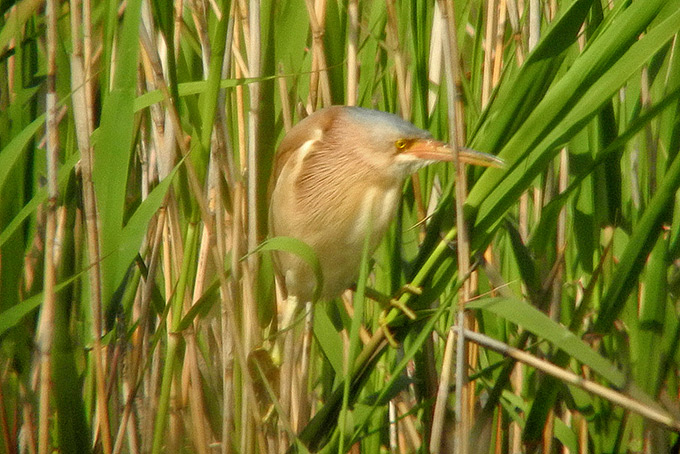 Yellow Bittern Ixobrychus sinensis, © Nial Moores
Yellow Bittern Ixobrychus sinensis, © Nial MooresVon Shrenck’s Bittern Ixobrychus eurhythmus. Recorded on six dates (18th, 19th, 22nd, 26th, 29th and 30th) and in five different locations, each time singles - with the exception of a female seen and a male heard booming in the main marsh on 26th. None were recorded on Socheong during spring 2010.
Cinnamon Bittern Ixobrychus cinnamomeus. A male was very poorly-digi-scoped in one of the southern valleys on the 22nd.
Black-crowned Night Heron Nycticorax nycticorax. Surprisingly scarce on the island, being recorded on only three dates between 16th and 22nd, with a high count of only two.
Striated Heron Butorides striata. Recorded almost daily but only in small numbers, with the highest count being 6+ on the 30th.
Chinese Pond Heron Ardeola bacchus. Surprisingly scarce, being recorded on only nine dates with the highest count four on the 28th.
Eastern Cattle Egret Bubulcus coromandus. Recorded daily, with the highest count 55+ on the 30th.
Grey Heron Ardea cinerea. Recorded daily, with the highest count being 40 on the 16th. The presence of young juveniles was first noted on the 29th.
Purple Heron Ardea purpurea. Singles were recorded on two or three dates (16th, 24th and possibly on the 29th) with the high-count between two and six on the 20th.
Great Egret Ardea alba. Recorded in small numbers daily with all records considered to refer to modesta. The highest count was 15 on the 19th.
Intermediate Egret Egretta intermedia. Recorded in small numbers almost daily, with the highest count of eight on the 19th and again on the 29th.
Little Egret Egretta garzetta. Recorded on nine dates with the highest count being five on the 30th.
Chinese Egret Egretta eulophotes. Singles were recorded on three dates (16th, 23rd [MP only] and the 30th).
Pelagic Cormorant Phalacrocorax pelagicus. Presumed to be breeding on the island. Only seen in small numbers offshore from the areas visited during this survey.
Temminck’s Cormorant Phalacrocorax capillatus. Widespread and fairly common, both on the sea and much more surprisingly (considering its absence from freshwater in other areas) in low tens also on the reservoir and in the main freshwater creeks in rice-field areas. Presumed to be a widespread breeder on the island largely in areas seldom visited by this survey.
Western Osprey Pandion haliaetus. Only one was recorded, on 21st and 22nd.
Crested Honey Buzzard Pernis ptilorhynchus. Recorded on six dates, with a total of 22 birds and a high count of seven (on the 19th).
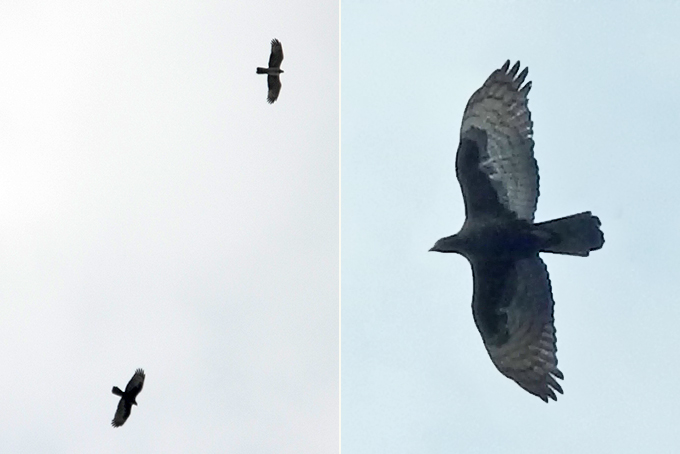 Crested Honey Buzzard Pernis ptilorhynchus, © Nial Moores
Crested Honey Buzzard Pernis ptilorhynchus, © Nial MooresChinese Sparrowhawk Accipiter soloensis. The most numerous raptor, being recorded on nine dates with a likely total of 55 passing through including a high count of 27 on the 26th.
Japanese Sparrowhawk Accipiter gularis. One was seen on the 21st.
Eurasian Sparrowhawk Accipiter nisus. A late male was seen on the 16th. The latest spring record on Socheong in 2010 was May 24th.
Pied Harrier Circus melanoleucos. A female was hunting the main marsh on the 24th.
Grey-faced Buzzard Butastur indicus. Recorded on seven dates with probably only 15 or 16 birds in total and the highest count eight on the 30th. This species appears to have a protracted northward migration – in stark contrast to its concentrated southward migration.
Amur Falcon Falco amurensis. Recorded on only four or five dates, with the high count four or five (on the 23rd). Most intriguing was a Second calendar-year male seen only in flight and only from below on 20th and perhaps again - though much more distantly - on 23rd. This striking individual had very dark underparts; an underwing strongly recalling Eurasian Hobby F. subbuteo (i.e. with heavily marked underwing coverts and a narrower dark trailing edge than usual in Amur), and a dark-looking tail (though barred on the outer tail feathers). The similarly dark-looking bird on the 23rd was seen largely from above and behind – when it showed very silvery primaries on the upperwing.
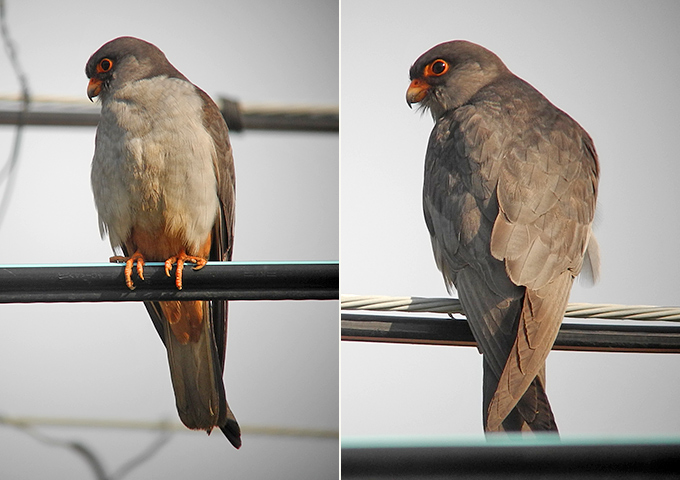 Amur Falcon Falco amurensis, © Nial Moores
Amur Falcon Falco amurensis, © Nial MooresEurasian Hobby Falco subbuteo. Present throughout in small numbers with the high count four, on 24th.
Peregrine Falcon Falco peregrinus. One or two seen on several dates, with the only remarkable observation being one carrying a freshly-killed crake sp. on the 29th.
White-breasted Waterhen Amaurornis phoenicurus. Singles were recorded on three different dates (18th, 21st and 30th) in three different parts of the island.
Ruddy-breasted Crake Porzana fusca. Present and vocal between the 21st and the 28th in the reed-marsh at Yeonhwa Ri, with two heard on 22nd.
 Ruddy-breasted Crake Porzana fusca, © Matt Poll
Ruddy-breasted Crake Porzana fusca, © Matt PollWatercock Gallicrex cinerea. A large dark rallid disappearing into thick cover in the southern valley on the 17th was presumed to be this species.
Common Moorhen Gallinula chloropus. Present throughout the period in the main wetland, in the larger rice-field creeks and in the Yeonhwa Ri reed-bed, with the highest count a conservative 15 on 19th and 26th.
Eurasian Coot Fulica atra. Present throughout in the main marsh (where chicks first noted on the 17th) and in one of the main rice-field channels. Highest count was a conservative 12+ on the 16th.
Far Eastern Oystercatcher Haematopus (ostralegus) osculans. Present throughout in small numbers, with two or more pairs aggressively defending breeding sites.
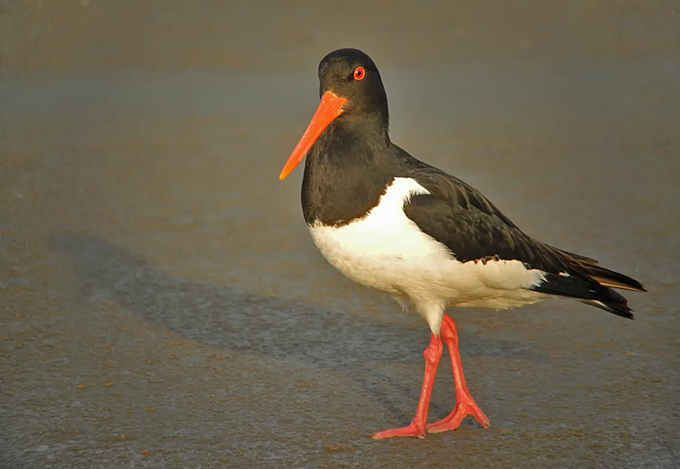 Far Eastern Oystercatcher Haematopus osculans, © Nial Moores
Far Eastern Oystercatcher Haematopus osculans, © Nial Moores Far Eastern Oystercatcher Haematopus osculans, © Nial Moores
Far Eastern Oystercatcher Haematopus osculans, © Nial Moores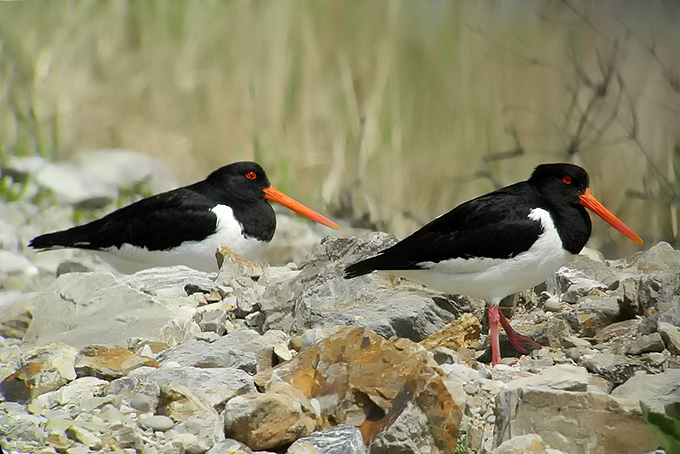 Far Eastern Oystercatcher Haematopus osculans, © Nial Moores
Far Eastern Oystercatcher Haematopus osculans, © Nial MooresBlack-winged Stilt Himantopus himantopus. Present throughout, with the highest count 18 recorded on the 16th, when one pair was seen to copulate. No nests were observed.
 Black-winged Stilt Himantopus himantopus, © Nial Moores
Black-winged Stilt Himantopus himantopus, © Nial Moores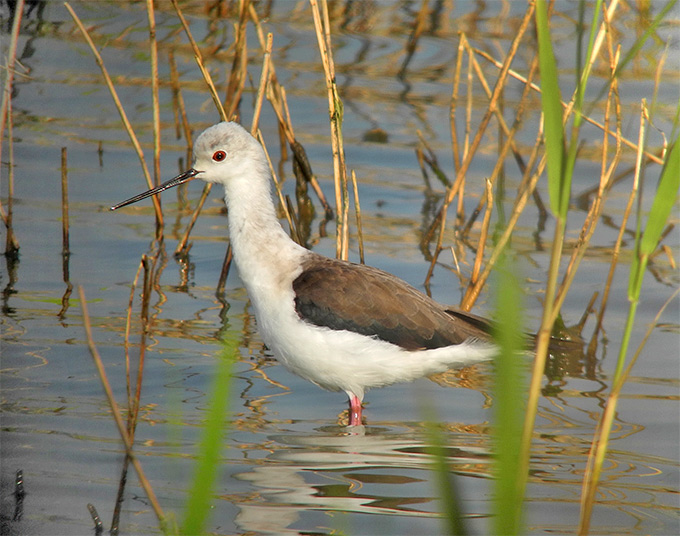 Black-winged Stilt Himantopus himantopus (note the bill base colour), © Nial Moores
Black-winged Stilt Himantopus himantopus (note the bill base colour), © Nial MooresPacific Golden Plover Pluvialis fulva. Only one record: a single on the 18th.
Little Ringed Plover Charadrius dubius. At least three pairs were present throughout and attempting breeding, with the first chick seen on the 30th.
Kentish Plover Charadrius alexandrinus. One or two pairs were present throughout, with two young chicks seen on the 16th and again (when happily they were rather larger!) on the 26th.
Mongolian Plover Charadrius mongolus. One was present in the main marsh on 16th and 17th.
Pin-tailed Snipe Gallinago stenura. Recorded on only two dates (19th and 22nd), with 5+ on the 19th the highest count.
Swinhoe’s Snipe Gallinago megala. Two large snipe on the 18th were presumed to be this species.
Common Snipe Gallinago gallinago. The only record was of 2+ heard after dark on the 19th.
Black-tailed Godwit Limosa limosa. One was present in the main marsh on the 22nd.
Spotted Redshank Tringa erythropus. A single was present on 19th.
Common Redshank Tringa totanus. One was in the salt-pans on the 29th and 30th.
Marsh Sandpiper Tringa stagnatilis. Recorded between the 16th and the 22nd, with the highest count four on the 16th and 17th.
Common Greenshank Tringa nebularia. Recorded on seven dates (last on the 29th), with the high count eight (on 19th).
Green Sandpiper Tringa ochropus. Recorded on only three dates (last on 22nd) with the high count four on 19th.
Wood Sandpiper Tringa glareola. Recoded on six dates (last on 28th), with the high count 5+ on 19th.
Grey-tailed Tattler Tringa brevipes. Recorded on six dates (last on 29th) with the high count of four on 16th.
Terek Sandpiper Xenus cinereus. Two on the 19th was the only record.
Common Sandpiper Actitis hypoleucos. Recorded on ten dates (last on 30th) with a high count of 15+ on the 19th.
Long-toed Stint Calidris subminuta. One on 17th was the only record.
Curlew Sandpiper Calidris ferruginea. One on 17th was the only record.
Black-tailed Gull Larus crassirostris. The most numerous species on the island during the present survey, with the highest day count being 600+ on the 30th. Nesting birds were observed at several locations, with the largest concentrations, however, being of birds in rice-fields – either following the rice-seeding machines or simply bathing and loafing. Is this kind of behaviour regular in other areas?
Mongolian Gull Larus mongolicus. Present throughout in small numbers, with the highest count being of eight plus on the 22nd. Most birds were adults, although a late First-winter was at the main marsh on the 29th.
“Taimyr Gull” Larus heuglini taimyrensis. An adult was on the main south beach on 17th and 19th.
Whiskered Tern Chlidonias hybrida. An adult was on the main reservoir on the 17th.
Oriental Turtle Dove Streptopelia orientalis. Present throughout and fairly numerous, with the highest count being 50 on the 19th.
Northern Hawk-cuckoo Hierococcyx hyperythrus. Surprisingly scarce, with singles heard on only four dates (19th, 21st, 22nd and 30th). During northward migration on Socheong in 2010, the highest day count was 11, on May 25th.
Lesser Cuckoo Cuculus poliocephalus. Recorded on six or seven dates, first on the 18th (when the high count of three was made). On 26th an extremely odd-looking cuckoo, perhaps a Lesser, was digi-scoped in the NE of the island. When time allows, a separate note on this bird (and on several odd-sounding cuckoos) will be posted on the Birds Korea blog.
Indian Cuckoo Cuculus micropterus. Recorded on 11 dates, first on 16th, with a high count of 6+ on the 30th. Surprisingly, considering how extremely elusive most are elsewhere, several individuals were approachable and allowed excellent views. Its obviousness on Baekryeong contrasts well with Socheong, where in 2010 the species was heard on only a few dates, first from May 20th, with none seen at all.
Listen to a recording of a singing Indian Cuckoo:
 Indian Cuckoo Cuculus micropterus, © Nial Moores
Indian Cuckoo Cuculus micropterus, © Nial Moores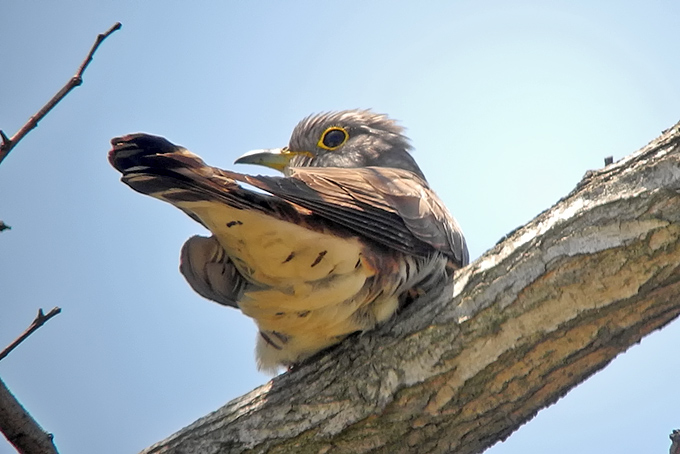 Indian Cuckoo Cuculus micropterus, © Nial Moores
Indian Cuckoo Cuculus micropterus, © Nial Moores Indian Cuckoo Cuculus micropterus, © Nial Moores
Indian Cuckoo Cuculus micropterus, © Nial MooresOriental Cuckoo Cuculus optatus. Heard on only three dates (the 22nd, 24th and 29th).
Common Cuckoo Cuculus canorus. Recorded daily, with at least ten heard on both the 19th and 21st. The first bubbling females were heard only from the 29th.
Oriental Scops Owl Otus sunia. Surprisingly scarce, with singles heard on only two dates (22nd and 28th).
Northern Boobook Ninox japonica. A single near the motel was heard on several dates between at least the 17th and the 22nd.
Grey Nightjar Caprimulgus jotaka. Only one record – a bird calling at midday on the 17th.
White-throated Needletail Hirundapus caudacutus. Recorded on only three or four dates, with the high count of 22 on the 16th.
Pacific Swift Apus pacificus. Present throughout in small numbers, with 100+ on the 20th and 290 on the 23rd the highest counts. A fairly similar high count (of 210) was recorded on May 21st 2010 on Socheong.
Oriental Dollarbird Eurystomus orientalis. Another species found in lower than expected numbers, recorded on only eight dates with the high count 15 on the 21st.
Black-capped Kingfisher Halcyon pileata. Present in small numbers throughout the period, with birds apparently in territory in three different parts of the island.
Common Kingfisher Alcedo atthis. Small numbers (of between one and two) recorded throughout the period, at several locations.
Great Spotted Woodpecker Dendrocopos major. Singles were present in two or three parts of the island.
Fairy Pitta Pitta nympha. A pitta-like call was heard very distantly towards the north of the island on the 16th, and one was seen briefly near one of the southern valleys on the 22nd. First heard in 2010 on Socheong on about May 29th.
Ashy Minivet Pericrocotus divaricatus. Recorded almost daily throughout the period in small numbers, last on the 30th, and with the highest count 10+ on the 19th.
Tiger Shrike Lanius tigrinus. First seen on the 17th and present in increasing numbers throughout the period, with 15+ on the 30th the highest day count. Many birds appeared to be paired up, and active display was seen in several locations. This species is a late migrant through the ROK, and appears to peak in number in early June.
 Tiger Shrike Lanius tigrinus, © Nial Moores
Tiger Shrike Lanius tigrinus, © Nial Moores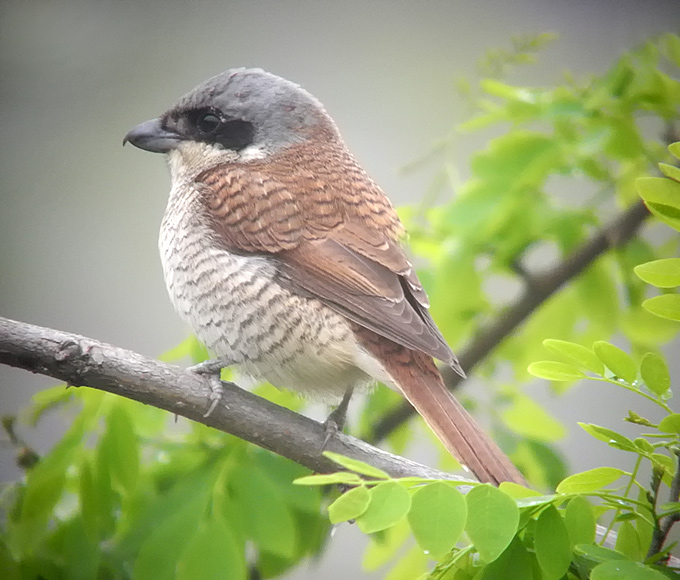 Heavily barred female Tiger Shrike Lanius tigrinus, © Nial Moores
Heavily barred female Tiger Shrike Lanius tigrinus, © Nial MooresBull-headed Shrike Lanius bucephalus. Present in small numbers throughout the period, with the first begging juveniles seen on the 24th and three families of begging juveniles seen on 30th.
Brown Shrike Lanius cristatus. Recorded daily, with peak numbers between the 19th (when 40 counted) and 21st (when 20 were counted). This compares with a peak count of 95 during a Whole Island Count on Socheong on May 25th 2010. As on Socheong, most appeared to be confusus, with probably <10 pure lucionensis and only two or three apparent nominate. At least two showed white wing-patches, with the bird on the 21st also showing several other features generally thought to be more associated with Red-tailed (aka Turkestan) Shrike Lanius phoenicuroides, a taxon as yet apparently unrecorded in the ROK.
Black-naped Oriole Oriolus chinensis. Present in small numbers throughout, with the highest count being 50 on the 21st.
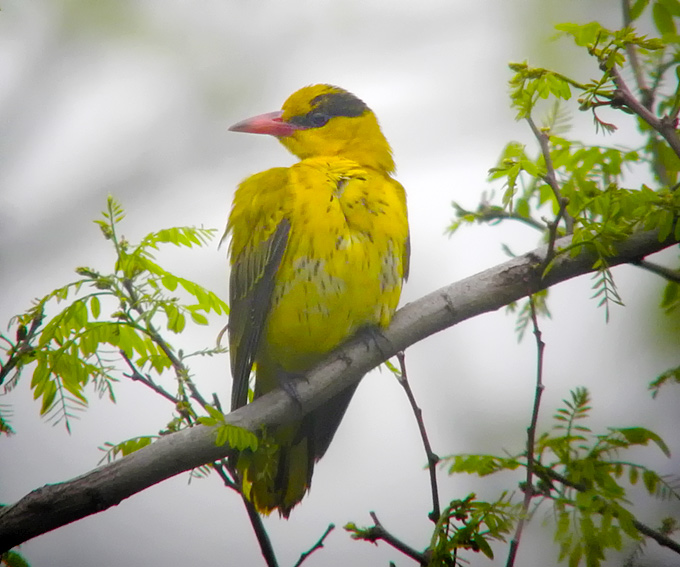 Black-naped Oriole Oriolus chinensis, © Nial Moores
Black-naped Oriole Oriolus chinensis, © Nial MooresBlack Drongo Dicrurus macrocercus. Recorded on nine dates (first on the 17th and last on the 30th), with a total of probably eight recorded moving through the island during the survey period.
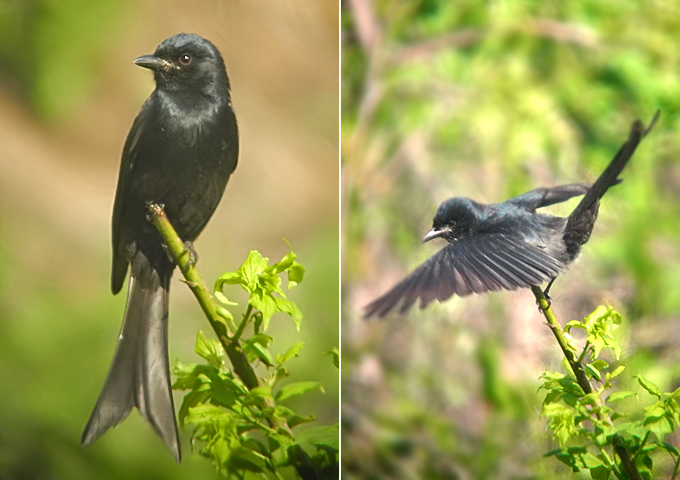 Black Drongo Dicrurus macrocercus, © Nial Moores
Black Drongo Dicrurus macrocercus, © Nial MooresAsian Paradise Flycatcher Terpsiphone paradisa. A stunning, full-tailed adult male was present in the west of the island on 22nd (seen and photographed by both NM and MP). There have probably been fewer than ten records nationally in recent decades.
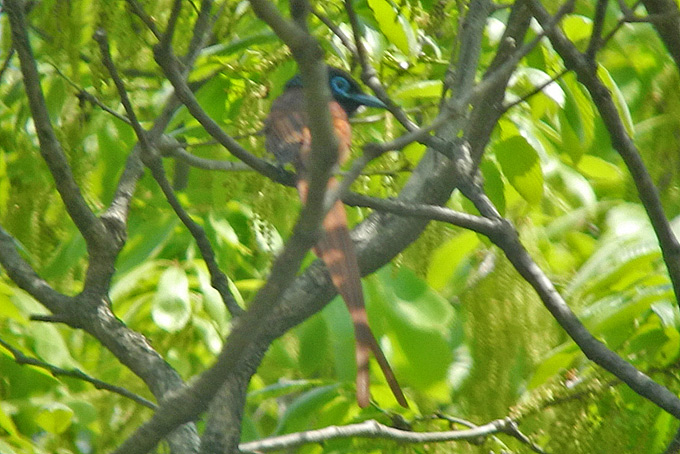 Asian Paradise Flycatcher Terpsiphone paradisi, © Nial Moores
Asian Paradise Flycatcher Terpsiphone paradisi, © Nial MooresBlack Paradise Flycatcher Terpsiphone atrocaudata. A probable was heard distantly towards the west of the island on the 17th and a full-tailed adult male was present in the north-east on the 20th and 21st.
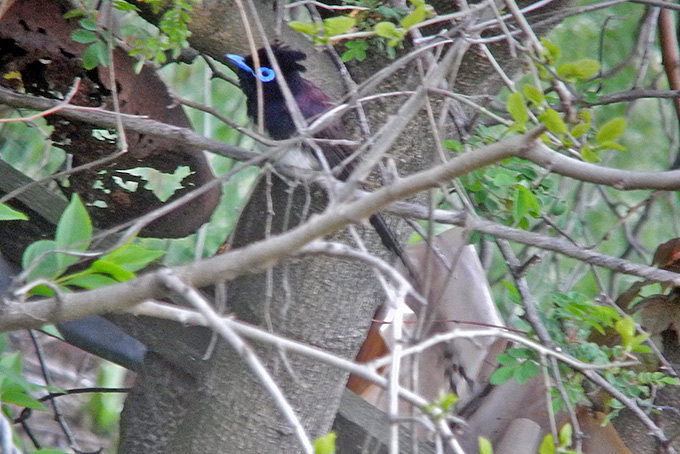 Black Paradise Flycatcher Terpsiphone atrocaudata, © Nial Moores
Black Paradise Flycatcher Terpsiphone atrocaudata, © Nial MooresEurasian Jay Garrulus glandarius. Present through the island in small numbers, with the highest day count being 10 on the 30th.
Azure-winged Magpie Cyanopica cyanus. Locally common on the island, most numerous in the west and southwest. The highest day count was 15 (on the 18th, 24th and 29th), with probably 50 or so present in total. At least some birds were paired up and apparently nesting. Future survey effort should confirm whether the present level of abundance is usual, or whether numbers are presently exceptionally high – as in many parts of the country this year.
Eurasian Magpie Pica pica. Present in small numbers in three or four areas on the island, with the highest day count being five, and the total island population probably numbering <20.
Daurian Jackdaw Coloeus dauuricus. One was heard moving north across the island on the 18th.
Large-billed Crow Corvus macrorhynchos. Present in small numbers throughout the island, with the highest count being 15+ on the 18th and 19th. As expected all birds seen and heard well belonged to the northern subspecies mandshuricus.
Japanese Waxwing Bombycilla japonica. One heard on 19th and in the west and one seen on 20th in the east of the island.
Coal Tit Periparus ater. One was heard singing on the 24th and 29th.
Yellow-bellied Tit Periparus venustulus. One was heard (and sound-recorded) singing in the southwest on the 30th. On Socheong in 2010, birds were recorded between May 2nd and 8th. Following the exceptional influx in 2012, it might be reasonable to expect that breeding will be attempted in several parts of the country this year?
Eastern Great Tit Parus minor. Present in small numbers throughout the island. Recorded daily with a high count of 30+ on 19th. Some were seen nest-building and it seems likely that 50-100 pairs were present in total on the island.
Chinese Penduline Tit Remiz consobrinus. Last recorded on the apparently rather late date of the 22nd, with the highest count being six on the 18th.
Asian Short-toed Lark Calandrella cheleensis / Lark sp. A harsh “duark-duark” call-note strongly recalling Asian Short-toed Lark was given several times in the extensive area of overgrown fields and crop fields near the reservoir on 18th. No bird was seen. A small lark was seen briefly (and had to be left unidentified) in this same area of fields in March.
Light-vented Bulbul Pycnonotus sinensis. Although only first-recorded in the ROK in 2002 (and apparently not yet listed for the DPRK) this species was recorded daily and increased steadily throughout the survey period, presumably due to the arrival of potential breeders. At least 18 were heard or seen on the 30th. Many birds were paired up, and several were seen carrying nest material (first from the 20th). The species was recorded in all the villages that were surveyed, with several noisy singers in e.g. Jincheon and Hwajungdong. It seems probable that between 25-50 pairs were present on the island at the end of May – presumably making it the main known centre of population of this species in the ROK.
Brown-eared Bulbul Hypsipetes amaurotis. Recorded daily, with a high count of 20 on the 19th. Unlike Light-vented Bulbul, there was no evidence of immigration during the period, and by the end of the month this appeared to have become only the second-commonest bulbul species on the island…
Sand Martin Riparia riparia / Pale Martin R. diluta. Brown-backed martins (either R. riparia or R. diluta, presumably of subspecies fohkienensis) were recorded more or less daily in small numbers between the 16th and 29th, with the highest count being 40+ on the 21st. At least one on 17th showed comb-like tarsal feathering (confirming its identity as a Pale Martin) while one on 26th showed a greatly reduced breast-band and several other “Pale features” and was also identified as a Pale Martin. A review of ID criteria and of records of these two extremely similar species in the ROK is required – especially as a preliminary review of images suggests that both species occur here during migration.
Barn Swallow Hirundo rustica. Recorded daily, with the highest counts being 300 on the 21st and 500 on the 22nd. Almost all individuals could easily be assigned to Korean- and East Asian-breeding gutturalis. However, one strikingly colored individual on the 30th was either of subspecies saturata or perhaps less likely tytleri. Although saturata is not recognised by some authorities, e.g. Dor et al. (2010), it is listed by Gill & Donsker (2013) with its range given as “e. Siberia” (with tytleri in “sc Siberia”). Confusingly, although Brazil’s East Asian field guide includes both saturata and tytleri in the text, and an image of tytleri resembling the Baekryeong bird (including reddish underwing coverts) there is frustratingly no information given on how actually to separate tytleri from saturata in the field. Information on any differences that can be detected in the field (if they indeed exist) would be warmly welcomed!
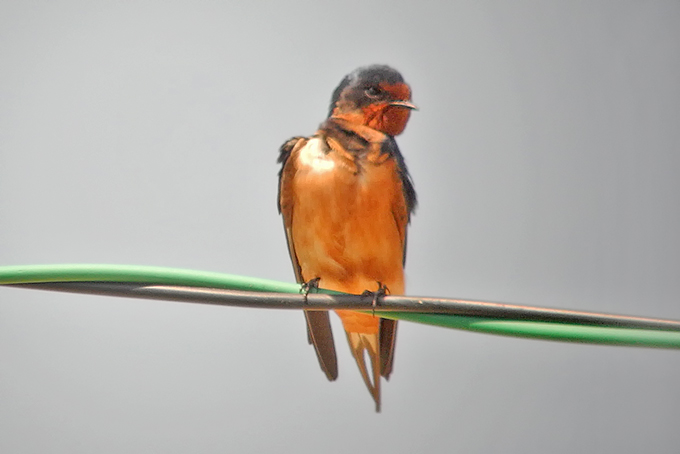 Barn Swallow Hirundo rustica, © Nial Moores
Barn Swallow Hirundo rustica, © Nial Moores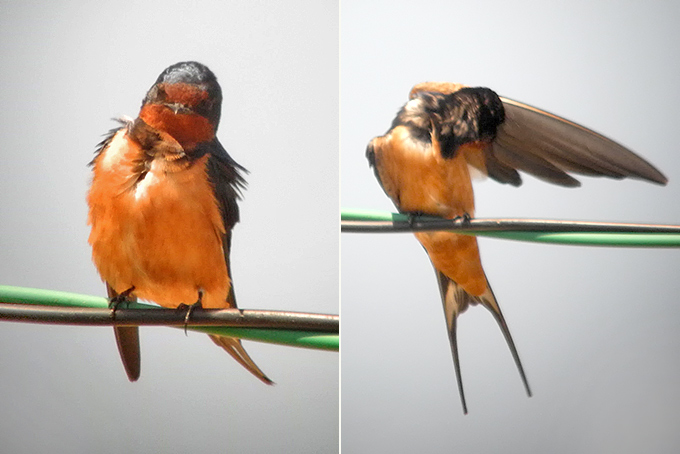 Barn Swallow Hirundo rustica, © Nial Moores
Barn Swallow Hirundo rustica, © Nial MooresCommon House Martin Delichon urbicum. Singles recorded on probably five dates, between the 20th and 30th, with at least seven present on the 26th.
Asian House Martin Delichon dasypus. There was only one confirmed sighting: one with the large mixed hirundine flock (potentially containing six species!) on the 26th.
Red-rumped Swallow Cecropis daurica. Recorded daily until the 29th, with the highest counts being 500 on the 21st and 250+ on the 26th. In Socheong in 2010, the highest count of Red-rumped Swallow was 165 (on May 25th).
Korean Bush Warbler Horornis borealis. Recorded daily, with the largest number of singers heard towards the end of the survey period (e.g. 25 on 28th and 20+ on 30th). Many of the late birds were probably migrants, as the peak count of Korean Bush Warbler on Socheong in 2010 was also reached in late May. However, many (20 across the island in total?) also appeared to be in territories occupied (at least) from mid-month.
Listen to a recording of a singing Korean Bush Warbler:
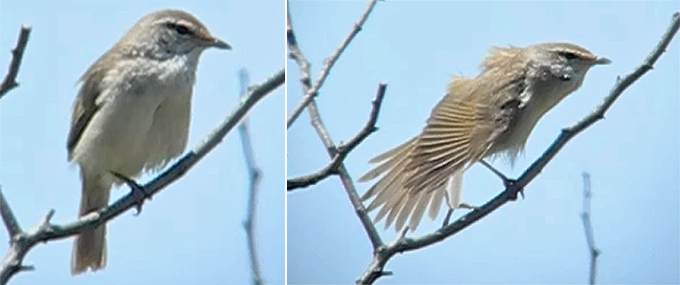 Korean Bush Warbler Horornis borealis, © Nial Moores
Korean Bush Warbler Horornis borealis, © Nial MooresLong-tailed Tit Aegithalos caudatus. Present in small numbers in several parts of the island. As in March, the only individuals that were seen belonged to the white-headed subspecies.
Dusky Warbler Phylloscopus fuscatus. Recorded daily in small numbers, with the highest counts being 15+ on the 21st and 20 on the 22nd. The numbers recorded were much lower than those recorded on Socheong in 2010, where there was a high count of 96 on May 20th.
Alpine Leaf Warbler Phylloscopus occisinensis. A recent split from Tickell’s Leaf Warbler, Alpine Leaf is apparently more obviously migratory, often shows some orangey wash on the throat and breast (evident in some images of this species taken in Korea), and appears to be the only one of the two species likely to occur in Korea. One was sound-recorded on the 19th and poorly seen in one of the southern valleys. Of interest one was also seen (and photographed) on Socheong island on 13th and 14th by Drs. Kim Sung-Hyun and Choi Soon-Kyoo (see: http://kwbs.or.kr/bbs/board.php?bo_table=search&wr_id=7488)
Radde’s Warbler Phylloscopus schwarzi. Recorded in small numbers throughout the period, with eight on the 24th the highest count.
Yellow-browed Warbler Phylloscopus inornatus. Recorded daily in small numbers until the 24th; last recorded on the 29th. Highest numbers were found after the passage of rain – with 15+ on the 20th the highest day count (which compares very poorly with the 114 recorded on Socheong on May 20th 2010)..
Hume’s Leaf Warbler Phylloscopus humei. One was well-seen on the 20th.
Arctic Warbler Phylloscopus borealis. Only a small number of Arctic Warbler-types could be confidently assigned to Artic Warbler sensu sticto on song. On 18th, however, all singers (7+) logged appeared to be Arctic Warbler, and it is likely that at least some of the 50 recorded as peak count on the 22nd also refer to this species.
Kamchatka Leaf Warbler Phylloscopus examinandus. Based on vocalizations, this taxon was probably the commonest of the Arctic Warbler-types from about the 24th, with perhaps 10-20 present on e.g. the 24th and 29th.
Japanese Leaf Warbler Phylloscopus xanthodryas. Based on vocalizations and the presence where these calls and songs were heard of some visually-striking individuals (with bright orange lower mandibles; yellow-washed supercilia, throat, flanks and vent, often contrasting with a broad white wing-bar; bright green-edged remiges; and subtly darker lateral crown stripes), this taxon – if identified correctly - was present on at least four dates, with two or three on the 24th, one or more on the 28th and 29th and perhaps three or more together on the 30th (when identification was made primarily on plumage and bare parts coloration as above).
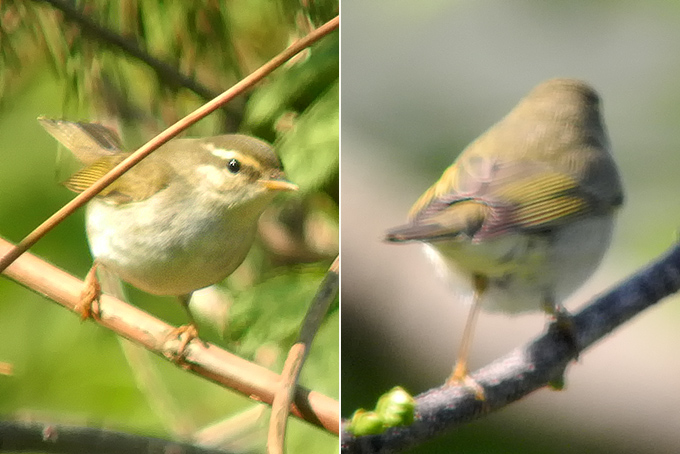 Japanese Leaf Warbler Phylloscopus xanthodryas, © Nial Moores
Japanese Leaf Warbler Phylloscopus xanthodryas, © Nial MooresTwo-barred Warbler Phylloscopus plumbeitarsus. Recorded on only five dates (first on 18th and last on 24th), with a high-count of only three (on the 18th).
Pale-legged Leaf Warbler Phylloscopus tenellipes. Present almost daily, with a modest high count of 10 on the 21st and 22nd.
Sakhalin Leaf Warbler Phylloscopus borealoides. One was heard singing at dawn near the main reservoir on the 19th. Presumably this is the first record for the greater Incheon area as the species has yet to be recorded on Socheong?
Eastern Crowned Warbler Phylloscopus coronatus. This apparently fast-declining species was recorded only in very small numbers daily until the 22nd, with the high count being only three (on 20th).
Oriental Reed Warbler Acrocephalus orientalis. Recorded daily, with the largest concentration being 50+ singers in the main marsh on several dates.
 Oriental Reed Warbler Acrocephalus orientalis, © Nial Moores
Oriental Reed Warbler Acrocephalus orientalis, © Nial Moores Oriental Reed Warbler Acrocephalus orientalis, © Nial Moores
Oriental Reed Warbler Acrocephalus orientalis, © Nial MooresBlack-browed Reed Warbler Acrocephalus bistrigiceps. Typically, one of the latest spring migrants through the ROK. Recorded daily in slowly increasing numbers, with the highest count during the period being 30 on the 30th.
Thick-billed Warbler Iduna aedon. Recorded more or less daily in small numbers, with the highest counts being four on the 22nd and eight on the 30th.
Lanceolated Warbler Locustella lanceolata. Surprisingly scarcely logged – either due to weather conditions this spring or / and perhaps to their low density within the vast amount of potentially suitable habitat. Recorded on only three dates, first on 19th, with a peak of only eight on the 22nd.
Middendorff's Grasshopper Warbler Locustella ochotensis. Like all other locustella, surprisingly scarce. Noted on only three dates, with one or two singing birds heard on the 18th and 19th and one seen by MP on 22nd.
Pallas’s Grasshopper Warbler Locustella certhiola. As above, surprisingly scarce, being logged on only four dates, with a high count of 12 (on 22nd) in just one small area of Yeonhwa Ri.
Gray’s Grasshopper Warbler Locustella fasciolata. The song of this taxon was heard (and recorded) certainly only on the 29th. Distant singers (either this species or L. amnicola) were also possibly heard briefly on the 30th and 31st.
Far Eastern Cisticola Cisticola (juncidis) brunniceps. Two in the main marsh on the 16th was the only record.
Chestnut-flanked White-eye Zosterops erythropleurus. Recorded almost daily, with the highest count being 50+ on the 22nd.In all, only between 100 and 150 were logged during the survey period.
Red-billed Starling Spodiopsar sericeus. Present in two areas of the island only between the 23rd and 25th, with the high count 3-5 on the 22nd.
White-cheeked Starling Spodiopsar cineraceus. First recorded on the 23rd; subsequently several pairs were found nest-building or food-carrying in the far southwest of the island.
Daurian Starling Agropsar sturninus. Small numbers were recorded on seven dates, with the high count being seven on the 23rd.
Chestnut-cheeked Starling Agropsar philippensis. Recorded on two dates: two together on the 17th and one on the 20th.
White’s Thrush Zoothera aurea. Ones or twos were heard singing on several dates in several parts of the island.
Grey-backed Thrush Turdus hortulorum. The only widespread thrush during the present survey, with 20+ on the 19th and 10+ on the 22nd the highest counts. Most records were of singing birds, presumably in territory.
Chinese Blackbird Turdus merula mandarinus. Two were first found the 21st in the north-east, and appeared to be still present on 31st.
Eyebrowed Thrush Turdus obscurus. Recorded on eight dates (last on the 29th), with a high count of only 8+ (on the 19th).
Pale Thrush Turdus pallidus. Remarkably scarce during the survey period, being recorded on only five dates with a high count of only two (on 21st).
Dusky Thrush Turdus eunomus. Recorded on five dates, with two on the 19th and the last record an adult male on the extremely late date of the 28th. The last record of spring 2010 on Socheong was May 20th.
Siberian Rubythroat Luscinia calliope. Remarkably scarce, being recorded on only three dates, with the high count only 4+ on the 21st.
Siberian Blue Robin Luscinia cyane. Recorded on only five dates, with the last on the 26th.
Rufous-tailed Robin Luscinia sibilans. Recorded on six dates, last on the 24th, with the highest count 6+ on the 21st.
Daurian Redstart Phoenicurus auroreus. Noted on only two dates (last on 19th).
Stejneger’s Stonechat Saxicola stejnegeri. Recorded on four dates, last on 21st.
Blue Rock Thrush Monticola solitarius. Recorded almost daily in small numbers, with the highest count being six on the 30th.
Grey-streaked Flycatcher Muscicapa griseisticta. Recorded more or less daily, with the highest counts being 25 on the 19th and 20 on the 22nd.
Dark-sided Flycatcher Muscicapa sibirica. Recorded more or less daily from the 17th, with the highest count 22 (in one small area of the island) on the 20th.
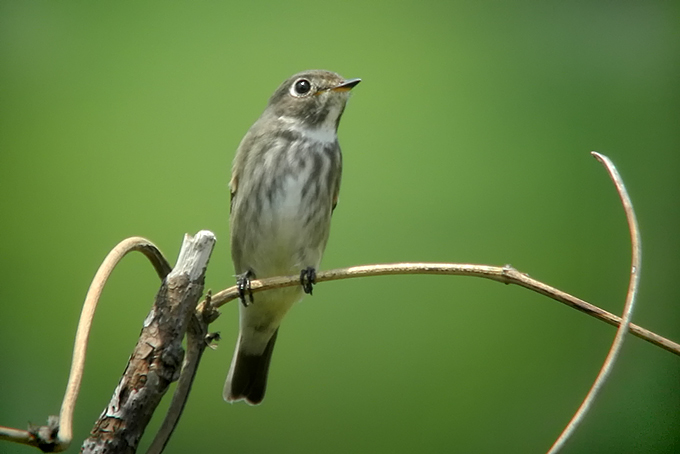 Dark-sided Flycatcher Muscicapa sibirica, © Nial Moores
Dark-sided Flycatcher Muscicapa sibirica, © Nial MooresAsian Brown Flycatcher Muscicapa latirostris. The most numerous flycatcher, recorded daily, with the highest counts 79 (in only one very small area of the island) on the 20th and 60+ on the 22nd.
Yellow-rumped Flycatcher Ficedula zanthopygia. Recorded daily between the 17th and 24th, and last noted on the 30th. The highest count was ten on the 19th.
Narcissus Flycatcher Ficedula narcissina. Singles recorded in different parts of the island on three dates (the 18th, 19th and 21st).
Slaty-blue Flycatcher Ficedula tricolor. An adult male was seen very poorly in the west of the island by NM and MP during the afternoon of the 21st. Seen poorly in flight twice from behind (NM) and side (MP) and once when perched in a small pine (by NM only) . Identification was based on: 1) Small size and fairly short tail (recalling e.g. Red-breasted Flycatcher); 2) Clean, in parts “shiny”, blue upperparts, recalling Red-flanked Bluetail, and white underparts; 3) Prominent white basal third to half of the otherwise blue-toned dark outer tail feathers; 4) Lack of dark throat; and 5) Dark, blue?, markings/suffusion on the breast sides when the bird was perched. Unfortunately the bird was extremely secretive and elusive and was also in a highly sensitive part of the island. There are no previous records in the ROK, so the species will be added to Category 4 of the Birds Korea Checklist.
Mugimaki Flycatcher Ficedula mugimaki. Singles were noted on six dates, with two the highest count (on 20th).
Red-breasted Flycatcher Ficedula parva. One heard (in direct comparison with two calling F. albicilla) was presumably the same as the bird poorly digi-scoped at the same spot immediately afterwards in the northeast on 20th (with images showing orange tones to the base of the lower mandible; warm tones to the “face”; and dark brown rather than blackish longest uppertail coverts – though all much faded and overexposed in the images).
Taiga Flycatcher Ficedula albicilla. Logged on eight dates (last on the 30th) with the highest count three (on the 19th).
Russet Sparrow Passer rutilans. A pair that was first noted on 19th and photographed nest-building on 21st (NM and MP) was still present in the same area on 28th (NM and RN). However, it is unclear whether the nest survived the torrential rain that fell on the 27th.
Forest Wagtail Dendronanthus indicus. Recorded on only seven dates, last on 30th (when one was in song), with a high count of four on the 22nd.
Eastern Yellow Wagtail Motacilla tschutschensis, Recorded more or less daily, with highest counts 45 on the 18th and 30+ on the 22nd.
Citrine Wagtail Motacilla citreola. One was heard giving the diagnostic “zzrup” call on the 17th.
White Wagtail Motacilla alba. Recorded daily in small numbers, with all records limited to leucopsis.
Richard’s Pipit Anthus richardi. Recorded on only seven dates (last on the 30th) with the high count 15 on the 21st.
Blyth’s Pipit Anthus godlewskii. Only one record: one in the far west on the 19th.
Olive-backed Pipit Anthus hodgsoni. Recorded almost daily until the last on the 24th, with the highest count 15 on both the 19th and 20th (latter in only one very small part of the island).
Pechora Pipit Anthus gustavi. Recorded on nine dates, with the highest count seven on the 19th. All birds seen well were of the nominate subspecies.
 Pechora Pipit Anthus gustavi, © Nial Moores
Pechora Pipit Anthus gustavi, © Nial MooresRed-throated Pipit Anthus cervinus. Singles were recorded on only three dates, last on 21st.
Buff-bellied Pipit Anthus rubescens. One on the 16th was the only record.
Brambling Fringilla montifringilla. One on the 19th was apparently the only record.
Hawfinch Coccothraustes coccothraustes. Recorded on eight dates between the 18th and the 29th, with high counts of 12 on the 21st and 15 on the 26th.
Chinese Grosbeak Eophona migratoria. Recorded daily from the 18th, with a high count of 60 on the 19th (which included one flock of 45). Several males were heard and seen giving excited rolling calls to females – presumably as part of pair-formation.
Japanese Grosbeak Eophona personata. A group of five together on the 19th was the only record.
Common Rosefinch Carpodacus erythrinus. Rather scarce, being recorded on only four dates between the 18th and 22nd, with two birds together in different parts of the island.
Grey-capped Greenfinch Carduelis sinica. Present throughout in small flocks (maximum day count of 20) or in family groups – including several birds of the year.
Eurasian Siskin Carduelis spinus. Recorded in small numbers (between 1-6 birds each day) until the 26th, with the last record on the 30th.
Meadow Bunting Emberiza cioides. The commonest bunting during the period, with the highest day count being 40+ on the 19th. Many birds were paired up and apparently in territory (suggesting a likely breeding population of c. 50 pairs on the island).
Tristram’s Bunting Emberiza tristrami. Recorded daily in small numbers until the 24th, with the highest count five on the 16th, and the last record on the 30th.
Chestnut-eared Bunting Emberiza fucata. Recorded on eight dates, with the highest count being 6+ on the 21st, and with three seen in potential breeding habitat on the 30th.
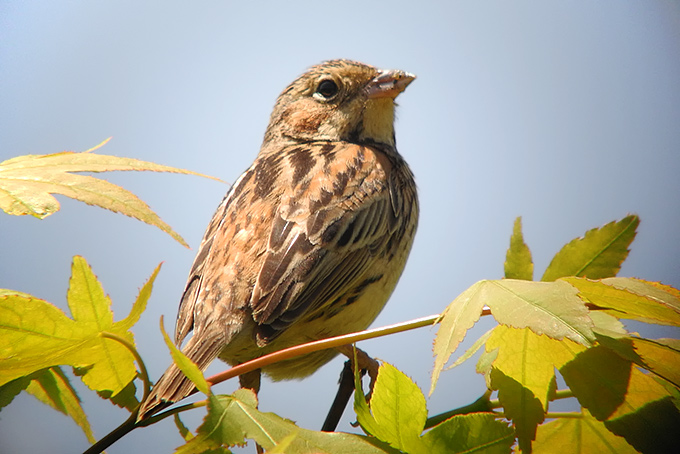 Chestnut-eared Bunting Emberiza fucata, © Nial Moores
Chestnut-eared Bunting Emberiza fucata, © Nial MooresLittle Bunting Emberiza pusilla. Recorded on only five dates between the 18th and 24th, with the highest count ten on the 19th.
Yellow-browed Bunting Emberiza chrysophrys. A typically early-migrating bunting species, recorded on only two dates during the survey, last on 23rd (MP only).
Yellow-throated Bunting Emberiza elegans. Widespread in small numbers on the island, with several pairs apparently in territory and breeding.
Chestnut Bunting Emberiza rutila. Apparently scarce nationwide this spring (probably primarily due to the paucity of suitable winds), and while recorded on nine dates (last on the 29th) the high count was only 20+ (on 21st).
Black-faced Bunting Emberiza spodocephala. Recorded daily in steadily decreasing numbers, with the highest count a modest 30+ on the 21st. One female personata was present on at least the 21st.
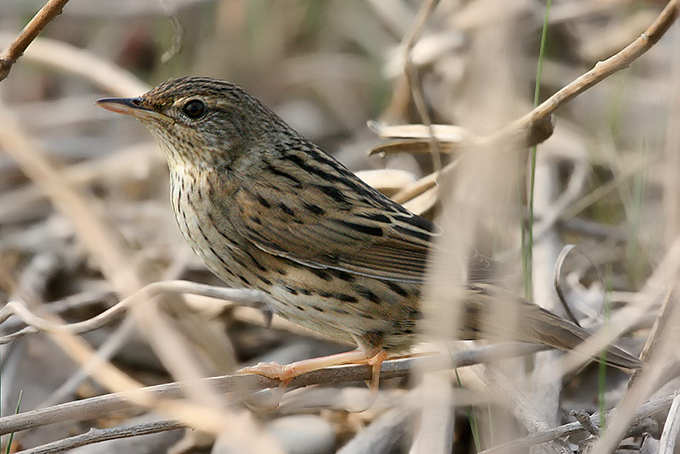
References
- Brazil, M. 2009. Birds of East Asia. Helm Field Guides.
- Dor, R., Safran, R., Shedlon, F., Winkler, D. & I. Lovette. 2010. Phylogeny of the genus Hirundo and the Barn Swallow subspecies complex. Molecular Phylogenetics and Evolution 56 (2010) 409-418.
- Gill, F. & D. Donsker (Eds). 2013. IOC World Bird List (v 3.3). Available at http://www.worldbirdnames.org [Accessed on June 5th 2013].
- Moores, N. 2012. The Distribution, Abundance and Conservation of the Avian Biodiversity of Yellow Sea habitats in the Republic of Korea. Doctoral thesis, University of Newcastle, Australia.



